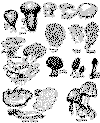by Ernest Thompson Seton
[Please note that I have removed portions of Seton's original text on this page. If you need a copy of the original page for historic purposes, please contact me. -- Rick]
We have in America about two thousand different kinds of Mushrooms or Toadstools; they are the same thing. Of these, probably half are wholesome and delicious; but about a dozen of them are deadly poison.
There is no way to tell them, except by knowing each kind and the recorded results of experience with each kind. The story about cooking with silver being a test has no foundation; in fact, the best way for the Woodcraft Boy or Girl is to know definitely a dozen dangerous kinds and a score or more of the wholesome kinds and let the rest alone.
Spore-Prints
To make a spore-print, cut off the stem of the toadstool and lay the gills down on a piece of gray paper under a vessel of any kind. After a couple of hours, lift the cap, and radiating lines of spores will appear on the paper. If it is desired to preserve these, the paper should be first covered with thin mucilage. The color of these spores is the first step in identification.
Poisonous Toadstools
Deadly Toadstools
[Some of] the deadly toadstools known in North America are pictured on the plate, or of the types shown on the plate. The Deadly Amanita may be brownish, yellowish, or white. The Yellow Amanita of a delicate lemon color.
The White Amanita of a pure silvery, shiny white.
The Fly Amanita with cap pink, brown, yellow, or red in the center, shaded into yellow at the edge, and patched with fragments of pure white veil.
The Frosty Amanita with yellow cap, pale cadmium in center, elsewhere yellowish white, with white patches on warts.
All are very variable in color, etc.
Wholesome Toadstools
It is a remarkable fact that all the freaks, like clubs and corals, the cranks and tomfools, in droll shapes and satanic colors, the funny poisonous looking Morels, Inkcaps, and Boleti are good, wholesome food, but the deadly Amanitas are like, ordinary mushrooms, except that they have grown a little thin, delicate, and anaemic.
All the Puffballs are good before they begin to puff, that is as long as their flesh is white and firm.
All the colored coral toadstools are good, but the White Clavaria is said to be rather sickening.
All of the Morels are safe and delicious. (Except Gyromitra esculenta. )
So also is Inky Coprinus, usually found on manure piles.
The Beefsteak Mushroom grows on stumps, chiefly chestnut. It looks like raw meat and bleeds when cut. It is quite good eating.
The common mushroom is distinguished by its general shape, its smell, its pink or brown gills, its white flesh, brown spores, and solid stem.
Mushroom Growing
(See Article on "How to Raise Money")
Books Recommended
EDIBLE AND POISONOUS FUNGI of NEW YORK, by Charles H. Peck. Published by New York State Museum, Albany, 1895.
EDIBLE FUNGI of NEW YORK, by Charles H. Peck. Published by New York State Museum, Albany, 1906.
THE MUSHROOM BOOK, by Nina L. Marshall. Published, 1902, at New York by Doubleday, Page & Co.
ONE THOUSAND AMERICAN FUNGI, by McIlvaine & Macadam, Published by the Bobbs-Merrill Company of Indianapolis, 1902.
MUSHROOMS, by G. F. Atkinson. Holt & Co.
THE MUSHROOM, by M. E. Hard. The Ohio Library Company, Columbus, Ohio.

